As opposed to the normal approach I take with these finals breakdowns, I’ll do a brief rundown of how the match transpired but I mainly want to look at the results of this contest going forward for each of the players involved. The Yushan World Open final saw two players, very closely matched in style; World Champion and No. 1: Judd Trump, and the fastest player on the tour and Haining Open winner: Thepchaiya Un-Nooh.
But first, the brief breakdown. The match was Trump-all-the-way; Un-Nooh found himself playing catch-up the whole final. Trump developed a 7-2 lead after the first session, where the 7th frame included a 3-miss rule that resulted in a forfeited frame for Un-Nooh. Despite Un-Nooh doing well to bring it back to 8-5, Trump showed his new championship resolve to finish the final 10-5.
Un-Nooh put up a respectable performance against the current best player in the world and should have a lot of confidence in his attempt to claw back into the game, rather than retreat and only claim a small handful of frames. Experience is something that can help Un-Nooh at this stage and with his recent exposure at the Haining Open and now this final, it’s a step in the right direction. And Un-Nooh shouldn’t forget how close he ran Trump in the first round of the World Championship. Another big final such as this one will put him at arm’s length of the Top 16.
And then there’s Trump. He continued what he’s been doing for the past 12 months. Absolutely paving the way forward and running away with his No. 1 position in the one and two-year rankings. This win puts Trump’s ranking tally at 13, matching him with Ding and within reaching distance of Selby and Robertson at 16. The way things have been going, it’s only a matter of time and don’t be surprised if that is equalled this season. But Trump is taking the right approach and mentality towards it by aiming for 20 first, then seeing what happens from there.
Trump is starting to develop the aura that Selby has in which he doesn’t need to play his best to beat anyone. He can afford to make mistakes but he now has that fear-factor which can carry him in a game where he doesn’t need to be at his top form. Another way in which Trump is starting to remind me of Selby is that it seems the best time to deal with him in a tournament is in the early rounds. Similarly to Selby, the further Trump makes it in an event, the stronger he will be. Trump was taken to a deciding frame 3 times in the World Open (which included a Close Encounters of the Third Kind this season against Joe Perry), but what once may have shaken him has now turned into a resolve of steel.
There is a tweet from Phil Mudd which shows all of Trump’s wins in the last 12 months and how much he has earned from these events. In those prize winnings alone, he has earned almost £1.2m. And we are almost back to where the barrage began: the Northern Ireland Open.
The thing that impresses me most about Judd Trump nowadays is the way he presents and carries himself on top of his tremendous talent. He is really starting to turn into ‘the guy’ to take snooker forward and bring in new generations of viewers and fans. If he continues like this, he will be the main name associated with the sport!





